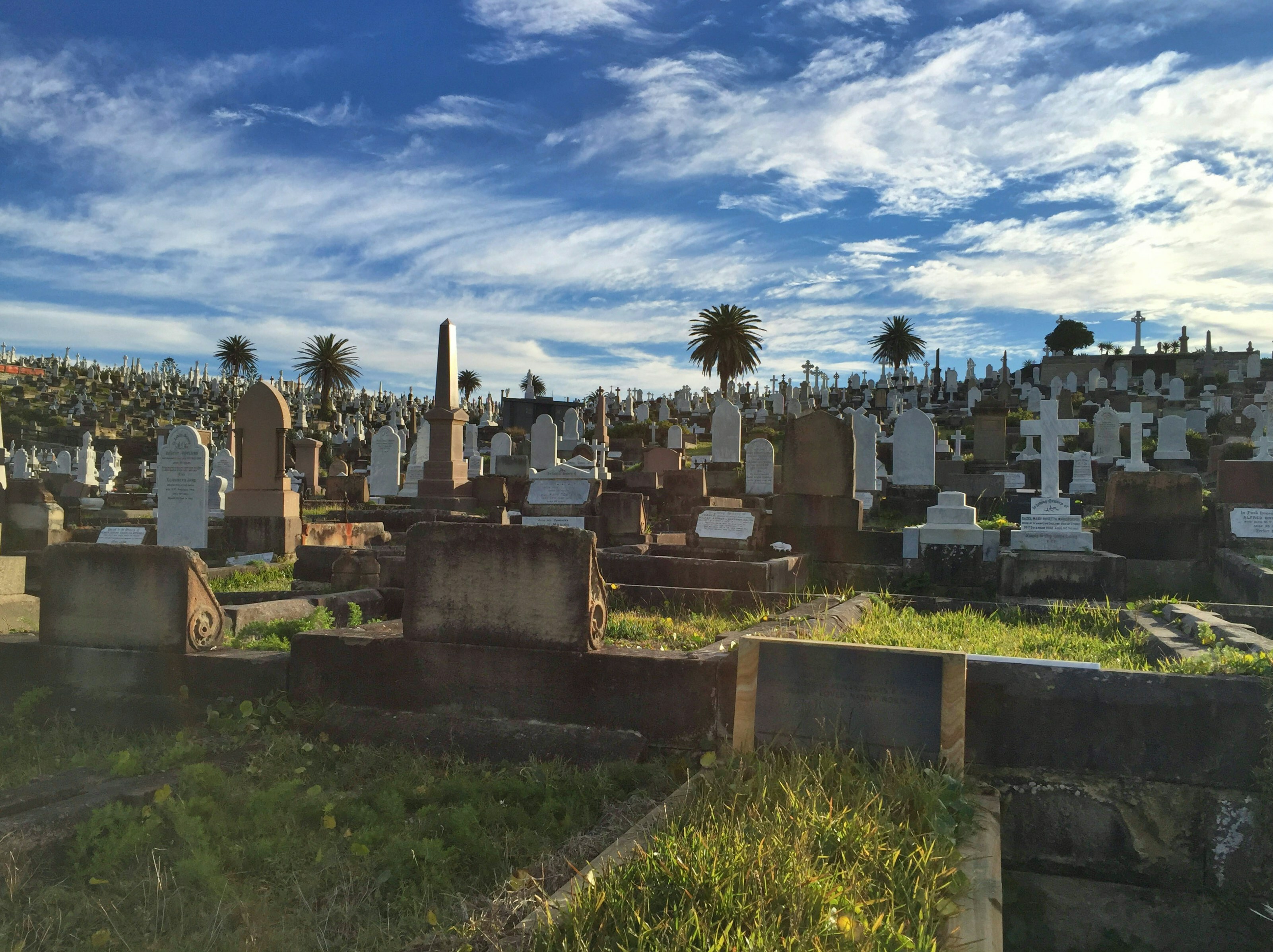Final Resting Places: Sydney's Oldest Cemeteries
Tradition, culture, and history wind together in some of the oldest burial grounds in the country.
Author
Laura Barling
Topics

Funerary and burial rites are so significant to humans that monuments built to the dead thousands of years ago still fascinate us today.
Whole fields of study are dedicated to the history of death, dying, and what comes after. People have been burying and mourning their dead for more than 100,000 years, and many of those traditions remain unchanged today. As the oldest city in Australia, Sydney has it's fair share of historical resting places (though some have been lost to urbanisation and expansion), each of which are deeply entwined with the social and cultural history of the city.
The Lost Cemeteries of Sydney
Old Sydney Burial Ground
Sydney's first official European Christian burial ground opened in 1972, on the site where Town Hall sits today. For the next 28 years until its closure in 1820, most people who died in Sydney Town were buried here, both convicts and citizens; in death, we are all equal, regardless of our status in life.
Devonshire Street Cemetery
After the closure of the Old Sydney Burial Ground to make way for the construction of what is now Sydney Town Hall, a cemetery was opened at the Brickfields, and was commonly known as Devonshire Street Cemetery or the Sandhills then; now, the site plays host to Central Railway Station.
The Sydney Jewish Cemetery, Devonshire Street was the first burial ground for the Sydney Jewish Community. From 1832 to 1860, the Devonshire Street Cemetery served as the main burial ground for the Sydney Jewish Community.
Rookwood General Cemetery: The Necropolis
In 1862, 200 acres of land at Haslem's Creek was purchased, in what was to be the first step in the establishment of the Southern Hemisphere's largest cemetery, Rookwood Necropolis. Many of the oldest graves in the cemetery were relocated from their original burial places, both Old Sydney Burial Ground and Devonshire Street Cemetery.
The first burial reportedly took place in 1867, when the body of 18-year-old John Whalan was laid to rest, although this isn't recorded in the burial register. Officially, the first burial was in the Roman Catholic section of the cemetery: Catherine McMullen, a 14-month-old toddler, interned on January 7th, 1867.
Rookwood Cemetery is the world's largest cemetery from the Victorian area still in operation, today continuing to serve as the final resting place for over a million people. Spread across 314 hectares, it reflects the cultural diversity and history of the people of Sydney, with dedicated sections for various denominations and cultures, chapels, and over 430 unique internment grounds and memorial areas; among these are the Sydney War Cemetery, the Garden of Remembrance, and the Jewish Memorial.
Each year over 1,900 interments and commemorations are held, representing over 90 separate cultural and religious groups.
The History of Some of Sydney's Oldest Cemeteries
Botany Bay
On the southern headland of the entrance to the bay lies the grave of Forbus Sutherland, a Scottish seaman from the Endeavour who died of tuberculosis the day after the ship anchored in Botany Bay.
Sutherland is the first European to be buried in a marked grave on Australian soil, and the nearby headland was named Point Sutherland by Captain James Cook in his memory.
St John's Cemetery, Parramatta
Used from 1789 to 1824, St John's is Australia's oldest surviving cemetery, containing the oldest known undisturbed grave in Australia; a slab of stone which bears the inscription "H.E. Dodd 1791".
H.E. Dodd is Henry Edward Dodd, butler to Gov. Phillip, buried a year after the opening of the cemetery, and his grave is significant in it's own right, being the site of the first public funeral held in the colony.
St John's Cemetery is notable for being the final resting place of over 50 First Fleet graves, along with many other historically significant early European settlers.
Waverly Cemetery
Located on top of the cliffs at Bronte in the Eastern Suburbs of Sydney, Waverly Cemetery has perhaps the most dramatic backdrop of any cemetery located in Australia.
Formally opened on August 1st 1877, the first internment at Waverly took place 3 days later, in the afternoon of August 4th 1877. It's Australia's most well-known cemetery, and since opening, has been host to over 86,000 internments, including Australian poet Henry Lawson.
What Did We Do Before Cemeteries: Informal Burial Grounds
Many of those who died in the early years of the colony were buried informally (not in a consecrated cemetery), and remnants of these can be seen in various places around Sydney. Most often, these early settlers were buried within a mile of their place of arrival. The first informal European burial grounds were located around the area of the Rocks, but nothing of the burials in the first five years of settlement remains; what little we do know comes from offhand descriptions in other documents and letters.
Aboriginal people in the Sydney region followed traditional cultural practices, either burial or cremation followed by burial, up until 1820. Notable Aboriginal Australians who were buried according to European customs include Arabanoo and Ballederry, who were interned in the grounds of the first Government House, and Bennelong and Nabaree, interned in the estate of James Squire.

Places of Contemplation and Remembrance
Cemeteries not only provide a place of contemplation and remembrance for the ones we love, but they also serve as living historical archives, helping us to reflect on our connections to community and tradition; they bridge generations, preserve memories, and stand as a cultural landmark, being host to ceremonies and traditions that reinforce community bonds and our collective identity.
Sydney's cemeteries are time capsules into the past, commemorating individuals and telling the broader history of the development of Sydney and it's diverse cultural history and landscape
Laura Barling
©2024 Safe Will Pty Ltd - All Rights Reserved